Foča
Foča (Serbian Cyrillic: Фоча, pronounced [fôtʃa]) is a town and a municipality located in Republika Srpska in eastern Bosnia and Herzegovina, on the banks of Drina river. As of 2013, the town has a population of 12,234 inhabitants, while the municipality has 18,288 inhabitants.
Foča
Фоча | |
|---|---|
Town and municipality | |
   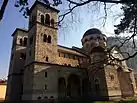  | |
 Coat of arms | |
 Location of Foča within Bosnia and Herzegovina | |
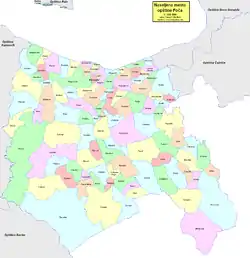 | |
| Coordinates: 43°30′23″N 18°46′29″E | |
| Country | |
| Entity | |
| Government | |
| • Municipality president | Milan Vukadinović (SNSD) |
| • Municipality | 1,134.58 km2 (438.06 sq mi) |
| Population (2013 census) | |
| • Town | 12,334 |
| • Municipality | 18,288 |
| • Municipality density | 16/km2 (42/sq mi) |
| Time zone | UTC+1 (CET) |
| • Summer (DST) | UTC+2 (CEST) |
| Area code(s) | 58 |
| Website | www |
Foča houses some faculties (including the Medical and Orthodox Theological Faculty of Saint Basil of Ostrog) from the Istočno Sarajevo University. It is also home to the "Seminary of Saint Peter of Sarajevo and Dabar-Bosna", one of seven seminaries in the Serbian Orthodox Church. Foča was also, until 1992, home to one of Bosnia's most important Islamic high schools, the Madrassa of Mehmed-paša. The Sutjeska National Park, which is the oldest National Park in Bosnia and Herzegovina, is located in the municipality.
History
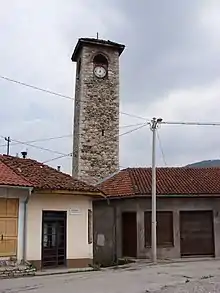
Early history
The town was known as Hotča during medieval times. It was then known as a trading centre on route between Ragusa (now Dubrovnik) and Constantinople (now Istanbul, Turkey). Alongside the rest of Gornje Podrinje, Foča was part of the Serbian Empire until 1376, when it was attached to the Kingdom of Bosnia under King Tvrtko. After Tvrtko's death, the town was ruled by the dukes of Hum, most notably was Herzog Stjepan. Foča was the seat of the Ottoman Sanjak of Herzegovina established in 1470, and served as such until 1572, when the seat was moved to Pljevlja.
World War II
In 1941, the Ustaše killed the leading Serbs in Foča.[1] Between December 1941 and January 1942 over two thousand Bosnian Muslims were killed in Foča by the Chetniks as act of vengeance for repression over Serbs by Muslims in ranks of Ustaše.[2] Additionally Chetniks attacked Ustaše and in Foča in August 1942.[2]
On 13 February 1943, Pavle Đurišić reported to Draža Mihailović the actions undertaken by the Chetniks in the Foča, Pljevlja, and Čajniče districts: "All Muslim villages in the three mentioned districts were totally burned so that not a single home remained in one piece. All property was destroyed except cattle, corn, and senna."[3]
In the operation Chetnik losses "were 22 dead, of which 2 through accidents, and 32 wounded. Among the Muslims, around 1,200 fighters and up to couple of thousands of civilian victims of both nationalitys."[3] Đurišić said what remained of the Muslim population fled and that actions were taken to prevent their return.[3] The municipality is also the site of the legendary Battle of Sutjeska between the Tito's Yugoslav Partisans and the German army. A monument to the Partisans killed in the battle was erected in the village of Tjentište.
Bosnian War
In 1992, at the onset of the Bosnian War, the city fell under the control of the Army of Republika Srpska. From 7 April 1992 to January 1994, Serb military, police and paramilitary forces enacted a campaign of ethnic cleansing in the area of Foča against Bosniak civilians . By one estimate, around 21,000 non-Serbs left Foča after July 1992.[4] Most of them settled in the town of Rožaje in Montenegro until the war ended. Only about 10 Muslims remained at the end of the conflict.[5] Thirteen mosques including the Aladža Mosque were destroyed and the 22,500 Muslims who made up the majority of inhabitants fled.[6] The Tribunal Judges determined beyond a reasonable doubt that the purpose of the Serb campaign in Foča was, among others, "to cleanse the Foča area of Muslims" and concluded that "to that end the campaign was successful.[5]
In numerous verdicts, the International Criminal Tribunal for the former Yugoslavia (ICTY) ruled that the ethnic cleansing, killings, mass rapes, and the deliberate destruction of Bosniak property and cultural sites constituted crimes against humanity. According to the Research and Documentation Center (IDC), 2,707 people were killed or went missing in the Foča municipality during the war. Among them were 1,513 Bosniak civilians and 155 Serb civilians.[7] Additionally, Bosnian Serb authorities set up rape camps in which hundreds of women were raped.[8][9] Numerous Serb officers, soldiers and other participants in the Foča massacres were accused and convicted of war crimes by the ICTY.
Post-war period
In 1995 the Dayton Agreement created a territorial corridor linking the once-besieged city of Goražde to the Federation entity; as a consequence, the northern part of Foča was separated to create the municipality of Foča-Ustikolina. The ethnically-cleansed town was renamed Srbinje (Serbian Cyrillic: Србиње), "place of the Serbs". In 2004, the Constitutional Court of Bosnia and Herzegovina declared the name change unconstitutional, and reverted it back to Foča.
Since the war around 4,000 Bosniaks have returned to their homes in Foča, and several mosques have been re-built.[6] This has taken place largely due to the administration of Zdravko Krsmanović, who was mayor from 2004 to 2012. In the 2012 elections, however, Krsmanović was defeated and a new mayor, Radisav Mašić, was elected with support of parties SDS and SNSD.
The Aladža Mosque was rebuilt from 2014 and reopened in May 2019.[10]
In October 2004, members of the Association of Women Victims of War (Udruzenje Žene-Žrtve Rata) attempted to lay a plaque in front of the Partizan sports hall (used in 1992 also as a rape camp) to commemorate the terrible crimes that occurred there.[11][12] Around 300 Bosnian Serbs, including members of the RS Association of the Prisoners of War, prevented the plaque from being affixed.[13]
The Partizan sport hall was reconstructed by UNDP,[14] with EU funding, following a selection by the Foča municipal council,[15] also with the participation of elected representatives of local returnees.[16]
In 2018 and 2019, the association of war victims have been commemorating rape as a weapon of war by congregating in front of Karama's House in Miljevina and of the Partizan sport hall in Foca on the International Day for the Elimination of Sexual Violence in Conflict (19 June). [17]
Settlements
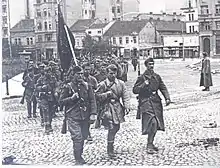
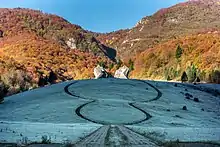
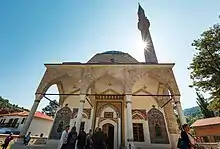
Aside from the town of Foča, the municipality includes the following settlements:
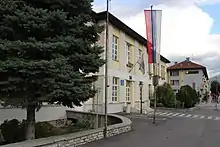
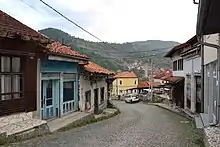

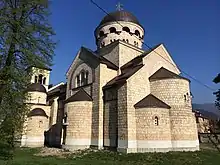
- Anđelije
- Bastasi
- Bavčići
- Beleni
- Bešlići
- Biokovo
- Birotići
- Bogavići
- Borje
- Borovinići
- Brajići
- Brajkovići, Foča
- Brod
- Brusna
- Budanj
- Bujakovina
- Bunčići
- Bunovi
- Cerova Ravan
- Crnetići
- Cvilin
- Čelebići
- Čelikovo Polje
- Ćurevo
- Daničići
- Derolovi
- Donje Žešće
- Drače
- Dragočava
- Dragojevići
- Đeđevo
- Fališi
- Filipovići
- Glušca
- Godijeno
- Gostičaj
- Govza
- Gradac
- Grandići
- Grdijevići
- Hum
- Huseinovići
- Igoče
- Izbišno
- Jasenovo
- Ječmišta
- Jeleč
- Jošanica
- Kolakovići
- Kolun
- Kosman
- Kozarevina
- Kozja Luka
- Kratine
- Krna Jela
- Kruševo
- Kunduci
- Kunovo
- Kuta
- Lokve
- Ljubina
- Marevo
- Mazlina
- Mazoče
- Meštrevac
- Miljevina
- Mirjanovići
- Mješaji
- Mravljača
- Njuhe
- Orahovo
- Papratno
- Patkovina
- Paunci
- Petojevići
- Podgrađe
- Poljice
- Popov Most
- Potpeće
- Previla
- Prevrać
- Prijeđel
- Prisoje
- Puriši
- Račići
- Radojevići
- Rijeka
- Rodijelj
- Slatina
- Slavičići
- Stojkovići
- Sorlaci
- Susješno
- Škobalji
- Štović
- Šuljci
- Tečići
- Tjentište
- Tođevac
- Toholji
- Trbušće
- Trtoševo
- Tvrdaci
- Ustikolina
- Velenići
- Vikoč
- Vitine
- Vojnovići
- Vranjevići
- Vrbnica
- Vučevo
- Vukušići
- Zabor
- Zakmur
- Zavait
- Zebina Šuma
- Zubovići
- Željevo
Demographics
Population
| Population of settlements – Foča municipality | ||||||||
|---|---|---|---|---|---|---|---|---|
| Settlement | 1948. | 1953. | 1961. | 1971. | 1981. | 1991. | 2013. | |
| Total | 39,171 | 39,178 | 47,173 | 48,741 | 44,661 | 35,389 | 18,288 | |
| 1 | Brod | 600 | 371 | |||||
| 2 | Đeđevo | 504 | 323 | |||||
| 3 | Foča | 6,763 | 9,257 | 11,530 | 14,335 | 12,334 | ||
| 4 | Miljevina | 1,763 | 973 | |||||
| 5 | Orahovo | 308 | 326 | |||||
| 6 | Patkovina | 600 | 298 | |||||
| 7 | Prevrać | 426 | 203 | |||||
| 8 | Štović | 458 | 201 | |||||
| 9 | Trbušće | 544 | 207 | |||||
Ethnic composition
| Ethnic composition – Foča town | |||||||
|---|---|---|---|---|---|---|---|
| 2013. | 1991. | 1981. | 1971. | ||||
| Total | 12,334 (100,0%) | 14,335 (100,0%) | 11,530 (100,0%) | 9,257 (100,0%) | |||
| Serbs | 7,901 (55,12%) | 5,663 (49,12%) | 4,148 (44,81%) | ||||
| Bosniaks | 5,526 (38,55%) | 4,414 (38,28%) | 4,309 (46,55%) | ||||
| Others | 522 (3,641%) | 49 (0,425%) | 77 (0,832%) | ||||
| Yugoslavs | 312 (2,176%) | 677 (5,872%) | 50 (0,540%) | ||||
| Croats | 74 (0,516%) | 87 (0,755%) | 152 (1,642%) | ||||
| Montenegrins | 632 (5,481%) | 514 (5,553%) | |||||
| Albanians | 8 (0,069%) | 7 (0,076%) | |||||
| Ethnic composition – Foča municipality | |||||||
|---|---|---|---|---|---|---|---|
| 2013. | 1991. | 1981. | 1971. | ||||
| Total | 18,288 (100,0%) | 35,389 (100,0%) | 44,661 (100,0%) | 48,741 (100,0%) | |||
| Serbs | 16,739 (91,53%) | 18,315 (45,21%) | 18,908 (42,34%) | 21,458 (44,02%) | |||
| Bosniaks | 1,270 (6,944%) | 20,790 (51,32%) | 23,316 (52,21%) | 25,766 (52,86%) | |||
| Others | 224 (1,225%) | 851 (2,101%) | 148 (0,331%) | 164 (0,336%) | |||
| Croats | 55 (0,301%) | 94 (0,232%) | 141 (0,316%) | 218 (0,447%) | |||
| Yugoslavs | 463 (1,143%) | 1,156 (2,588%) | 102 (0,209%) | ||||
| Montenegrins | 947 (2,120%) | 990 (2,031%) | |||||
| Albanians | 20 (0,045%) | 13 (0,027%) | |||||
| Slovenes | 10 (0,022%) | 15 (0,031%) | |||||
| Roma | 8 (0,018%) | ||||||
| Macedonians | 7 (0,016%) | 15 (0,031%) | |||||
Economy
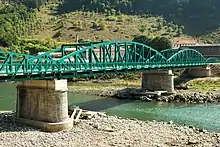
The following table gives a preview of total number of registered people employed in legal entities per their core activity (as of 2018):[18]
| Activity | Total |
|---|---|
| Agriculture, forestry and fishing | 280 |
| Mining and quarrying | 40 |
| Manufacturing | 188 |
| Electricity, gas, steam and air conditioning supply | 70 |
| Water supply; sewerage, waste management and remediation activities | 84 |
| Construction | 124 |
| Wholesale and retail trade, repair of motor vehicles and motorcycles | 375 |
| Transportation and storage | 158 |
| Accommodation and food services | 184 |
| Information and communication | 53 |
| Financial and insurance activities | 58 |
| Real estate activities | - |
| Professional, scientific and technical activities | 48 |
| Administrative and support service activities | 9 |
| Public administration and defense; compulsory social security | 647 |
| Education | 467 |
| Human health and social work activities | 619 |
| Arts, entertainment and recreation | 138 |
| Other service activities | 46 |
| Total | 3,588 |
Culture
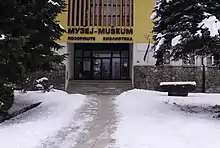
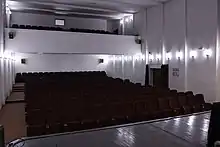
Museum of old Herzegovina and city theatre are located in Foča.[19]
Notable people
- Zehra Deović, folk singer
- Rade Krunić, footballer
References
- Stenton, Michael (2000). Radio London and Resistance in Occupied Europe: British Political Warfare 1939-1943. Oxford University Press. pp. 327. ISBN 0-19-820843-X.
- Tomasevich, Jozo (1975). War and Revolution in Yugoslavia, 1941-1945: The. Stanford University Press. p. 258. ISBN 0-8047-0857-6.
- Hoare, Marko Attila (2006). Genocide and Resistance in Hitler's Bosnia: The Partisans and the Chetniks. Oxford University Press. pp. 331–32. ISBN 0-19-726380-1.
- Blumenthal & McCormack 2008, p. 55.
- "Facts about Foča" (PDF). International Criminal Tribunal for the former Yugoslavia.
- Charter, David (28 May 2009). "World Agenda: US hopes for Bosnia rest on town mayor's shoulders". The Times. London, UK.
- Ivan Tučić (February 2013). "Pojedinačan popis broja ratnih žrtava u svim općinama BiH". Prometej.ba. Retrieved 4 August 2014.
- "ICTY: Blagojevic and Jokic judgement" (PDF). Retrieved 2012-04-05.
- "ICTY: Kunarac, Kovač and Vuković judgement" (PDF). Retrieved 2012-04-05.
- East Journal
- "Bosnian Serbs reject rape plaque". BBC News. 1 October 2004.
- "Rape as a Crime Against Humanity". Archived from the original on January 14, 2008. Retrieved 2008-01-14.
- OHR Media Roundup
- Glas Srpske
- European Parliament
- 2018 Start BiH, 2019 Oslobodjenje, 2019 Klix
- "Cities and Municipalities of Republika Srpska" (PDF). rzs.rs.ba. Republika Srspka Institute of Statistics. 25 December 2019. Retrieved 31 December 2019.
- "Gradsko pozorište Foča". muzej foca.com (in Serbian). Retrieved 2021-01-18.
- админ, град Крагујевац. "Градови пријатељи". Град Крагујевац (in Serbian). Retrieved 2021-01-18.
- Parallelus. "Međunarodna saradnja". Retrieved 2021-01-18.
